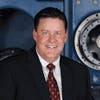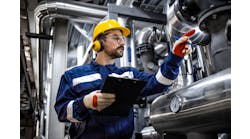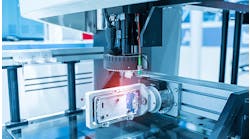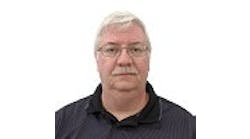Opportunities to include linear measurement are all around. Some applications are better than others. Our panel of experts explains where and when linear measurement makes sense.
Several manufacturing processes can include positioning a crane, inserting a part to a defined depth or checking material thickness. These might need more than limit switches, hard stops and manual checks. How could linear measurement devices be used?
Jeremy Miller, product manager—linear mechanics, Parker Hannifin, The application itself is really the key determining factor for what type of linear-measurement device or positioning capability is required. As highlighted, elements like limit sensors and hard stops can be used if the application only requires positioning between two points. If, however the application demands more incremental positioning, the next question is to what accuracy and/or repeatability is required. In the example of a crane or gantry-type system, the application may only require coarse positional accuracy, in the neighborhood of tenths of a millimeter or even multiple millimeters. A good example of this might be a palletizing machine. This level of precision is typically achievable through positional control via a servo or stepper motor, and often does not require additional linear measurement devices. A rotary encoder embedded on the back of a rotary servo motor to control a belt- or screw-driven actuator often has sufficient resolution to achieve application demands, even when including the inherent inaccuracy of the drive train and mechanical linkages.
On the other hand, examples like metrology applications such as precision measurement of material thickness or optical inspection, often require much higher precision motion. In this case linear-encoder technology is often implemented in combination with linear positioning stages. By affixing the point of measurement—encoder read head—directly to the load—point of interest—we can remove effects of inaccuracies due to mechanical linkages and drive-train elements. These elements can significantly impact the system accuracy when using a rotary encoder on the motor to position, as per the example above. With the use of a linear encoder, we are now able to achieve sub-micron level repeatability specifications.
Adrian Johnson, managing director, Contrinex USAControl System Integrators Association (CSIA) member, Analog inductive sensors provide precise linear output signals and are ideal for applications that require precise part positioning, material differentiation and measurement of size, distance and thickness. Typically used for distances up to 40 mm, these sensors provide a high-resolution analog signal that is proportional to the distance of the metal target from the sensor face.
Within the actuator or slide itself there are a couple ways to measure movement. Since all of the slides and actuators convert a rotary motion to a linear movement in a fixed ratio, a reliable way of determining linear position is to track the rotary motion of the motor. This is the typical approach for slide tables and gives users access to a wide variety of signal types. In most cases slides are ready to accept a customer-supplied motor. This allows the user to install a motor with the type of feedback she or he needs to integrate into the rest of the system, such as encoders or resolvers. The linear actuators take a similar approach but measure the rotary position of the drive screw rather than the motor. This allows use of a precision multi-turn potentiometer that yields an easy to read voltage signal that is easily scaled to the stroke length of the actuator.
In either case, the accuracy of the drive screw, or lead error, and the backlash, preloaded or not, are both important. Variation in the lead of the screw degrades the accuracy of the measurement, as does backlash. Similarly belt stretch in long systems will have lower accuracy. The precision of the measurement is more a matter of the resolution of the installed encoder or the controller reading the potentiometer.
How does linear measurement compare to motion control, encoders, vision systems and laser measurement?
The most beneficial methods include various measurement types because environmental conditions, product type, sampling rates and many other factors may vary the method you choose. Measurement throughput, repeatability, accuracy, cost, process control, part quality and ease of documentation are all at stake and must be considered. With vision systems, environments should be completely free of debris, so when measuring in a manufacturing environment, vision may not be your best choice. If you’re measuring very small parts, with many features and high sampling rates, vision or laser measurement would be your best choice.
Like the encoders that they are based on, linear sensors are available with a variety of interfaces, from analog to Ethernet. This makes them readily adaptable to a wide range or linear motion control applications.
Adrian Johnson, managing director, Contrinex USA Control System Integrators Association (CSIA) member, The popularity of inductive linear sensors has to do with their robust design for harsh environments, insensitivity to dirt/dust/heat, accuracy on reflective metals, simple setup to PLC and hence cost-effectiveness.
Can you offer any linear-measurement application examples or best practices that demonstrate how best to utilize it?
The concept of system repeatability vs. positional accuracy is an area where there is often confusion. It is critical to understand the difference between these two attributes when specifying linear-motion equipment, as specifying a high positional accuracy specification, when in reality repeatability is all that is truly needed, can often overburden the project with unneeded precision and thus cost. Repeatability comes into play when one attempts to move to the same commanded position continually. The repeatability of the system is the total range of the error moving to the same point repeatedly. Accuracy is the difference between a predicted move location and the actual achieved position. Many motion-control applications require motion between a finite set of positions within an addressable space. Think for example of a liquid handling/dispensing application where a multi-axis system might be dispensing samples into wells on a microtiter plate. These locations are all known in advance, and therefore, during programming of the controller, we can establish the exact coordinates with which to position to each time. In this case repeatability is the critical attribute, as we need to be able to repeatedly position to the same location each time. If, however, the specification is derived in terms of positional accuracy, it may require a higher precision stage to accomplish. The reason for this is that, as with the error mapping example, positional accuracy must account for inaccuracies within the system such as drive train or guidance, whereas taught positions limit the determining factors to attributes like backlash, as compounded inaccuracies of drive-train elements can be accounted for and essentially ignored. For this reason, linear stages are often able to achieve much greater levels of repeatability than that of positional accuracy.
Adrian Johnson, managing director, Contrinex USA, Control System Integrators Association (CSIA) member, Some of the more unique applications include monitoring vibration of a propeller shaft of a ship; setting multiple switch points on/off with one sensor; and hidden cam and valve measurement often found in process manufacturing.
Expected position = encoder count x lead / encoder lines per revolution
= 85,452 counts x 5 mm per revolution / 2,048 lines per revolution = 208.623 mm.
And the tolerance is a stack-up of the lead error and the repeatability. At this length, the lead error = screw length x accuracy
209 mm x .023 mm / 300 mm = .016 mm
And we use the root-mean-squared method of combining the tolerances:
Total tolerance = square root (lead error^2 + accuracy^2)
= square root (.016^2 + .005^2) mm = .0168 mm.
So, we would say the position of the slide is 208.623mm +/- .0168mm.














